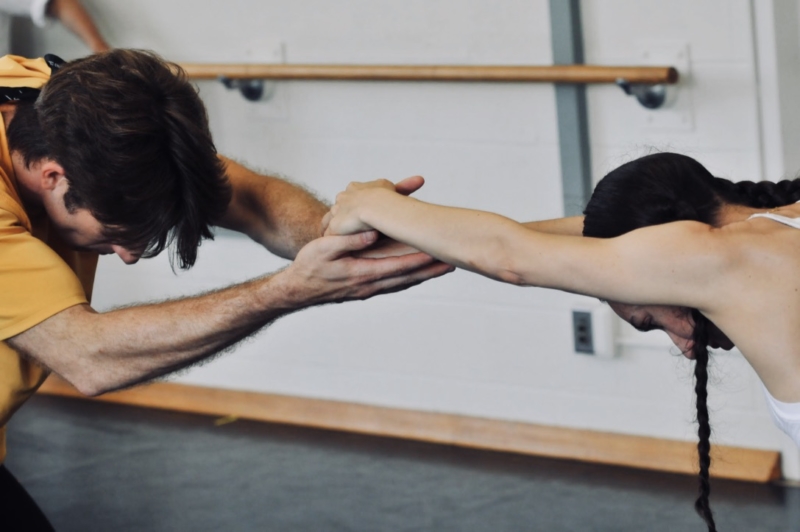Celebrating milestones and continuing two decades of creative collaboration, GroundWorks’ Spring Dance Series will feature farewell performances by founding company members Felise Bagley and Damien Highfield, as well as two world premiere works including Passenger by Executive Artistic Director David Shimotakahara.
“This series is definitely a milestone for GroundWorks, with Felise and Damien’s decision to retire from performing with the company,” he says. “For me, producing this series was bittersweet. I’m thinking back on all the things that have happened over the past 20 years to bring us here. I will so miss having Felise and Damien in the studio but there are so many things to celebrate.”
Shimotakahara reflects on his 20-year working relationship with Felise and Damien and what to expect from his new work, his 41st original creation for the company.
You have built such an enduring history with both Felise and Damien. Tell us how you’re feeling about this final performance.
Their level of commitment, in terms of their artistry, is getting more and more scarce. That level of commitment is hard to find these days. Not that it doesn’t exist, but if you’re lucky enough to work with someone like Damien and Felise – it’s such a gift. Because of what we were able to do over time and the ways we were able to develop and evolve our process in working and collaborating together.
Because dance is such a short career, and many dancers feel that they want to get as many kinds of experiences over a short span of time, the fact that Damien and Felise have been with the company for almost 20 years is exceptional.
What has been the best part of working with Damien?
Damien is an amazing artist and person. His partnering ability is exceptional; his ability to tune in to other dancers and make himself available. Plus, he’s a powerhouse, physically. I’ve always liked his energy. He’s got a natural feel for movement and transition and there’s a weight to his movement, which I love. He’s very intuitive.
What has been the best part of working with Felise?
Felise has this innate sense of form and coordination in her. And she has an incredible work ethic. She brings that into the studio every day. This willingness to work hard and to try things on. She has this elegance and this wonderful background in her training that has made her movement very clear. Felise is unabashedly our GroundWorks diva and I say that lovingly and we tease her about it, but she gets people’s attention because, aside from being a beauty, she has a strong sense of herself. It’s a wonderful thing to have and it’s a wonderful thing to have as an artist. She deserves the respect she commands.
What have they brought to the work?
The thing that Felise and Damien both bring every day is the respect for the work. That’s always been a great anchor especially with a company of five dancers. It’s not something I take for granted and I certainly value and what I want in my company.
Parting thoughts for them as they embark on new adventures?
They both have a vibrancy and energy and all the skills and experiences they’ve accumulated, I have no doubt whatever they do, they will be successful in it. What I hope both of them feel, is that they have had the complete experience. I think it’s fortunate that they’ve had this longevity. I hope they feel rewarded and satisfied in what they’ve accomplished.
Tell us about your world premiere work for the Spring Dance Series.
I’m using music by the American composer John Adams. He’s known for a lot of different work including winning the Pulitzer Prize in Music for On the Transmigration of Souls, a piece he did commemorating the victims of 9/11. I had an opportunity to work with his music for a new work I did with Cleveland Playhouse and the Cleveland Orchestra called The Good Peaches. It was a very interesting project that combined, text, acting, movement and the orchestra. It was just lovely to have Adams’ music played live.
Are you using a specific John Adams work, or is it a repertoire of pieces?
The particular piece of music I found, called John’s Book of Alleged Dances, premiered in 1994 with the Kronos Quartet. He composed it with the quartet in mind. But it was really the dances that were “alleged” – meaning the steps had yet to be invented. Since then, there have been a lot of choreographers who have taken it on.
I, too, was taken by it. It has wonderful variations and it’s so unique. It’s written with humor and has a funkiness which I really like. It was written for string quartet and prepared piano. There’s a percussive element to the piano underneath the string quartet which gives it kind of a crossover feel. There was a lot there that caught my imagination. I’m working with the music in different ways because it references different kinds of dance. It references different cultures, too. It opened up a huge range of possibilities for the dancers and I to explore.
What kinds of possibilities were you hearing in the music?
I was hearing all kinds of things, especially in terms of referencing culture. I hear early American Appalachian, I hear Eastern influences, I hear Spanish influences. I think the intention was to create a range in the styles of work. I’m letting it influence me as well. It will be a range of styles of dance and movement. There’s a lot in it rhythmically, it changes a lot, it’s intricate. I’m having a lot of fun with it.


